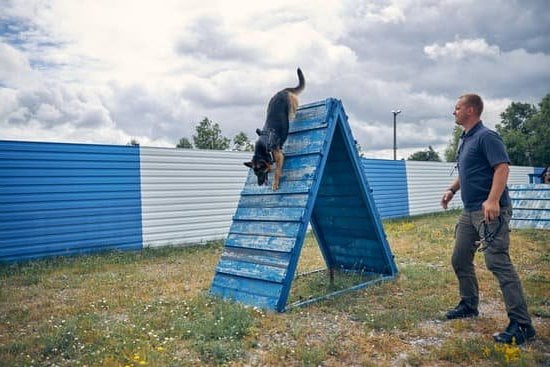How do you train your dog to stay with you in different environments and situations? Training your dog to stay is not only essential for their safety, but also for a harmonious and enjoyable relationship between you and your pet. In this article, we will explore the importance of training your dog to stay and provide valuable tips and techniques to help you achieve this goal.
When it comes to training your dog, one of the most crucial commands they should learn is the “stay” command. This command can potentially save your dog’s life in dangerous situations, such as when crossing a busy street or encountering aggressive animals. Additionally, teaching your dog to stay can improve their overall behavior and obedience, making outings and social interactions more manageable.
To effectively train your dog to stay, it’s important to start with the right tools. Choosing the appropriate leash and collar for training can make a significant difference in your dog’s ability to understand and follow commands. Furthermore, establishing a strong bond with your pet is crucial for successful training. By building trust and communication with your dog, they will be more receptive to learning new commands, including “stay”.
Choosing the Right Leash and Collar for Training
When it comes to training your dog to stay with you, choosing the right leash and collar is essential for successful training sessions. The collar and leash you select will play a significant role in how effectively you can communicate with your dog during training and ensure their safety.
Consider Your Dog’s Size and Breed
One of the most important factors to consider when choosing the right leash and collar for training is your dog’s size and breed. Larger breeds may require thicker, more durable collars and leashes, while smaller breeds may do well with lighter options. Additionally, certain breeds may benefit from specific types of collars, such as martingale collars for breeds with narrow heads or harnesses for brachycephalic breeds.
Choosing the Right Material
The material of the leash and collar also plays a crucial role in your dog’s comfort and safety during training. For example, nylon leashes are affordable and easy to clean but may cause irritation on sensitive skin, while leather leashes are durable but require maintenance to prevent cracking.
Similarly, there are various materials such as nylon, leather, chain, or fabric for collars. Each material has its pros and cons, so it’s important to consider your dog’s needs before making a selection.
Training Tools
In addition to standard leashes and collars, there are various training tools available that can aid in teaching your dog to stay with you. Retractable leashes provide flexibility during training sessions but should be used cautiously to prevent accidents. Head halters or no-pull harnesses are helpful for dogs that pull excessively on the leash, allowing for better control without causing discomfort.
Choosing the right leash and collar for training your dog is an important decision that can greatly impact the success of your training sessions. By considering factors such as size, breed, material, and additional training tools, you can ensure that both you and your dog have a positive experience during training sessions focused on staying together.
Establishing a Strong Bond With Your Dog
Building a strong bond with your dog is essential for successful training, especially when it comes to teaching them to stay with you. A strong bond creates trust and communication between you and your furry friend, making it easier for them to understand and follow your commands.
To establish this bond, spend quality time with your dog through activities such as playing, walking, and grooming. Additionally, positive reinforcement techniques such as treats, praise, and belly rubs can help strengthen the bond between you and your pet.
In addition to spending time together, it’s important to create a safe and comfortable environment for your dog. Providing them with a cozy bed, nutritious meals, and regular exercise shows that you care for their well-being. When dogs feel loved and secure in their environment, they are more likely to respond positively during training sessions.
Consistency is key when establishing a strong bond with your dog. By maintaining a consistent routine and approach to training, your pet will become familiar with what is expected of them. This consistency builds trust and reliability in your relationship with your dog.
| Importance | Benefits |
|---|---|
| Creates trust and communication | Makes it easier for the dog to follow commands |
| Strengthens the bond between owner and pet | Positive reinforcement techniques help build trust |
| Builds reliability in the relationship | Makes the training process smoother |
Teaching the Stay Command With Positive Reinforcement
Training your dog to stay with you is an essential skill that can keep them safe and well-behaved in various situations. One of the most effective ways to teach your dog to stay is by using positive reinforcement. This involves rewarding your dog for good behavior, which encourages them to repeat the desired action.
To start training your dog to stay, begin in a quiet and familiar environment with minimal distractions. Have your dog sit or lie down, then give the “stay” command while holding out your hand in a stop signal. Use a treat to lure them into staying in place, and once they do, give them the treat and plenty of praise. Repeat this process several times, gradually increasing the duration of their stay before giving the reward.
It’s important to use positive reinforcement consistently and patiently when teaching your dog to stay with you. This will help them understand what is expected of them and make the training process enjoyable for both of you. Be sure to use high-value rewards such as favorite treats or toys to motivate your dog and reinforce their good behavior effectively.
| Training Tips | Results |
|---|---|
| Use positive reinforcement consistently | Motivates the dog to repeat desired behavior |
| Start training in a quiet environment | Minimizes distractions for effective learning |
| Use high-value rewards | Effectively reinforces good behavior |
By following these steps and being consistent with your positive reinforcement, you can effectively train your dog to stay by your side in various situations. Remember that every dog learns at their own pace, so it’s important to be patient and celebrate small victories along the way. With time and practice, your dog will become more reliable in their ability to stay with you no matter where you go.
Practicing the Stay Command in Different Environments
When training your dog to stay with you, it is crucial to practice the stay command in various environments. This will help your dog generalize the behavior, meaning they will understand that the command applies regardless of the setting or distractions present. Here are some tips for practicing the stay command in different environments:
1. Start in a familiar environment: Begin practicing the stay command in a familiar and controlled environment, such as your home or backyard. This will allow your dog to understand the behavior before introducing new distractions.
2. Gradually introduce new environments: Once your dog has mastered the stay command in a familiar environment, slowly transition to new locations with mild distractions. This could be a quiet park or a friend’s house.
3. Increase difficulty over time: As your dog becomes more adept at staying in different environments, gradually increase the level of distractions and complexity of settings. For example, you can practice the stay command at a bustling dog park or during outdoor events.
By following these steps, you can effectively train your dog to stay with you across various environments, ensuring that they understand and obey the command regardless of external stimuli.
Ultimately, practicing the stay command in different environments is essential for reinforcing your dog’s understanding of this behavior and solidifying their training. Remember to use positive reinforcement and patience as you expose your furry friend to new surroundings while practicing their obedience skills.
Troubleshooting Common Challenges in Training Your Dog to Stay
Training your dog to stay by your side can be a rewarding experience for both you and your furry friend. However, there are common challenges that dog owners may face during the training process. Here are some troubleshooting tips to help you overcome these challenges:
- Practice in low-distraction environments: If your dog is having difficulty staying focused on you, start practicing the stay command in a quiet and familiar environment. This will help your dog understand the behavior you expect from them before gradually introducing distractions.
- Use high-value treats: Sometimes, dogs may not be motivated enough to stay still if the rewards are not enticing. Consider using high-value treats or toys during training sessions to keep your dog engaged and motivated to obey the stay command.
- Adjusting leash length: The length of the leash can also impact your dog’s ability to stay with you. If the leash is too short, it may restrict their movement and cause frustration, while a long leash may give them too much freedom. Find a comfortable length that allows your dog to move freely but still be under your control.
By addressing these common challenges, you can create a positive and effective training experience for your dog as they learn to stay by your side.
Remember, every dog learns at their own pace, so patience and consistency are key in overcoming any obstacles you may encounter during the training process.
When faced with challenges, observe how your dog responds and adjust your training methods accordingly. With dedication and perseverance, you can successfully train your dog to stay with you in various situations and environments.
Incorporating Distraction Training to Improve Your Dog’s Stay Command
Training your dog to stay focused and obedient, even in the face of distractions, is an essential skill that can be valuable in various situations. Whether you’re enjoying a leisurely walk in the park or trying to keep your pup safe in a crowded area, teaching your dog to maintain their stay command is crucial. So, how do you train your dog to stay with you amidst distractions?
One effective way to incorporate distraction training is by gradually exposing your dog to different levels of stimuli while practicing the stay command. Start by working on the stay command in a quiet and familiar environment, and then slowly introduce mild distractions such as gentle noises or slight movements. As your dog becomes more proficient at staying focused amid these minor distractions, gradually increase the level of difficulty by introducing more challenging elements like other animals or unfamiliar sounds.
Another effective method is to use positive reinforcement during distraction training. When your dog successfully maintains their stay despite the presence of distractions, reward them with treats, praise, or toys. This will help reinforce the behavior and motivate them to continue obeying the stay command even in distracting situations. Consistency and patience are key when incorporating distraction training into your dog’s routine.
It’s important to remember that every dog is unique, so it’s essential to tailor your distraction training approach based on your pet’s individual temperament and behavior patterns. By implementing these methods consistently and with patience, you can improve your furry friend’s ability to maintain their stay command no matter what distractions may come their way.
Reinforcing Good Behavior and Celebrating Progress
Once you have successfully taught your dog the basics of the stay command, it’s important to reinforce good behavior and celebrate their progress. This will further encourage your dog to continue obeying the stay command and strengthen the bond between the two of you.
Positive Reinforcement
One of the most effective ways to reinforce good behavior in your dog is through positive reinforcement. Whenever your dog successfully stays in place as instructed, be sure to reward them with treats, verbal praise, or affection. This helps your dog understand that staying when commanded is a desirable behavior and increases the likelihood of them repeating it in the future.
Consistency in Rewards
Consistency is key when reinforcing good behavior in your dog. Be sure to reward your dog every time they successfully execute the stay command, especially during initial training stages. Over time, you can gradually reduce the frequency of treats and rewards as your dog becomes more consistent in their obedience to the stay command.
Celebrating Progress
As your dog continues to improve their ability to stay by your side, it’s important to celebrate their progress. This could be done by introducing new challenges such as longer durations for staying put or navigating through distractions. Acknowledge and celebrate every milestone reached by your furry friend as this will motivate them even more and strengthen the bond between you both.
Overall, reinforcing good behavior and celebrating progress plays a crucial role in solidifying your dog’s understanding of the stay command and ensuring that they maintain consistent obedience in different situations.
Taking Your Dog’s Training to the Next Level
Once your dog has mastered the basic stay command, it may be time to take their training to the next level with advanced stay exercises. These exercises are a great way to challenge your dog and further strengthen their ability to stay on command in a variety of situations. By incorporating advanced stay exercises into your training routine, you can help your dog become more disciplined, focused, and responsive to your commands.
One advanced exercise to try is the “distance stay” where you gradually move farther away from your dog while giving the stay command. Start by taking just a few steps back and then gradually increase the distance as your dog becomes more proficient at staying in place. This exercise will test your dog’s ability to maintain focus and self-control even when you are not within immediate reach.
Another challenging exercise is the “duration stay” where you ask your dog to hold the stay position for an extended period of time. Begin by asking for a longer stay incrementally, starting with just a few seconds and gradually working up to several minutes. This exercise can help improve your dog’s patience and endurance while reinforcing their understanding of the stay command.
Finally, you can incorporate “distraction stay” exercises into your training routine, where you intentionally introduce distractions such as toys, other animals, or food while asking your dog to maintain their stay position. This will help teach your dog to remain focused on following commands despite external stimuli, ultimately strengthening their overall obedience and discipline.
By incorporating these advanced stay exercises into your training regimen, you can continue to challenge and engage your dog while helping them become even more reliable in following the stay command in various environments and situations. Remember that consistency and patience are key when practicing advanced exercises, so be sure to celebrate progress and reinforce good behavior as you work with your dog on these challenges.
Maintaining Consistency and Patience in Training Your Dog to Stay With You
In conclusion, training your dog to stay with you is a crucial skill that can ensure your pet’s safety and enhance your bond with them. By understanding the importance of this training, choosing the right equipment, and establishing a strong bond with your dog, you set the foundation for successful training. Teaching the stay command using positive reinforcement and practicing it in different environments will also contribute significantly to your dog’s ability to stay with you.
As you continue with training, it’s important to anticipate and address common challenges that may arise. Incorporating distraction training and celebrating progress will help improve your dog’s ability to stay focused on you in various situations. Additionally, taking your dog’s training to the next level by implementing advanced stay exercises will further solidify their understanding of this command.
Ultimately, maintaining consistency and patience is key in training your dog to stay with you. It is a process that requires time and dedication, but the rewards of having a well-behaved and attentive companion are certainly worth it. Remember that every dog is unique, so be patient as you work through any difficulties in training. With commitment and positive reinforcement, you can successfully teach your dog to stay by your side in any situation.
Frequently Asked Questions
How Do I Train My Dog to Stay With Me?
Training your dog to stay with you involves using positive reinforcement, like treats and praise, to encourage them to stay close. Start by practicing in a low-distraction environment and gradually work up to more challenging scenarios.
How Do I Train My Dog to Stay With Me and Not Run Away?
To prevent your dog from running away, start by teaching them a solid recall command using high-value treats and lots of practice. Gradually introduce distractions while reinforcing the behavior. Using a long leash for added safety during training can also be helpful.
How Do You Train Your Dog to Stay Beside You?
When training your dog to stay beside you, it’s important to establish a strong bond and trust through positive reinforcement. Use treats and praise to reward them for walking nicely beside you, and be consistent with your expectations. Practice in different environments to generalize the behavior.

Welcome to the blog! I am a professional dog trainer and have been working with dogs for many years. In this blog, I will be discussing various topics related to dog training, including tips, tricks, and advice. I hope you find this information helpful and informative. Thanks for reading!





